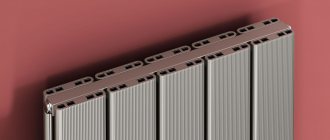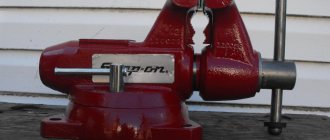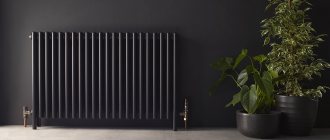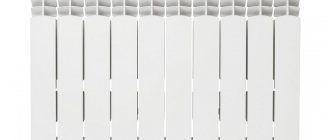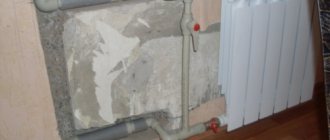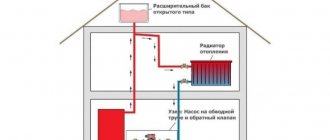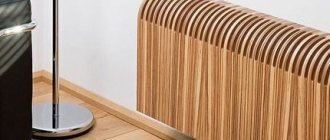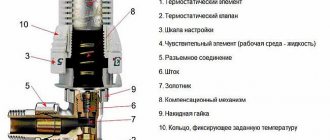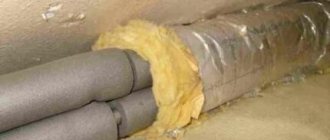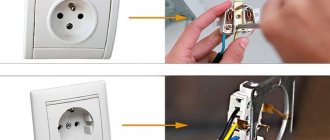The choice of heating devices for a water system always remains the prerogative of the homeowner, even when the installation is carried out by hired craftsmen. But choosing batteries based on the advice of sellers or reviews of Internet users is not easy - the former often do not understand the topic and repeat advertising slogans, the latter “praise their swamp,” which is understandable. To find out which heating radiators are best to choose for an apartment or private house, we suggest using a simple and understandable algorithm.
Instructions for choosing batteries - a simplified approach
Before you buy or order new heating radiators, you should quickly study the catalogs of large online stores. This will allow you to find out the price order and see the existing types of batteries. All convection water heating devices are divided into 4 groups:
- aluminum sectional;
- bimetallic - sectional and monolithic;
- cast iron;
- steel – panel and tubular.
Lyrical digression. You can read reviews and articles on resources that publish ratings of products from various brands. But the information will not bring much benefit - there are endless debates on forums and fake responses are written, and ratings are often compiled based on the TOP 10 manufacturers from the first pages of the search.
To select the power of heating radiators, you must first calculate the amount of heat consumed to heat each room. Calculation methods - by area, volume or heat losses of the building - are published in a separate article. How to choose the right batteries:
- Estimate the cost of a future purchase, weed out more expensive and too cheap heater options.
- Select models that you like in appearance, shape and color that fit well into your home interior. Pay attention to the height of the batteries so that they fit into the niches.
- If you live in an apartment in a high-rise building (9 floors or more), open the page with the technical characteristics of the selected radiators and find out the maximum operating water pressure - the device must withstand at least 12 Bar.
- For owners of private cottages, the pressure parameter is not of interest - models with any characteristics are suitable. If the house is heated with a wood or coal boiler, it is worth checking the maximum temperature of the coolant - the higher the figure, the better.
- Find out what connection methods are provided by the manufacturers of the selected batteries. The bottom line allows you to better hide the heating lines; with the side option, the pipes will have to be walled in the wall or left in plain sight.
- Find out the weight of the product and the installation method - floor or wall. Find out if the radiator comes with mounting brackets and liners, otherwise there will be additional costs. Radiator valves and Mayevsky tap are usually purchased separately.
To install the devices you will need footers, a Mayevsky tap with a key and hanging brackets - Make the final choice of model and determine the size of radiators by power. We will tell you how the actual heat transfer of 1 section (panel) is calculated at the end of this instruction.
Please note that we did not mention materials of manufacture and types of devices. In reality, this factor does not play a big role. Modern radiators differ little in technical parameters; only the heat transfer indicator remains important. The lower threshold of working pressure is only relevant in multi-storey buildings.
Next we will look at the design and characteristics of various batteries, comparing their advantages and disadvantages. But first, let’s dispel popular myths invented by advertisers.
Table. Comparison of operating pressure and application areas of various radiators
| Steel panel | Steel tubular | Aluminum | Bimetallic | Cast iron | |||||||
| Working pressure, atm. | 6 — 10 | 8 — 15 | 6 — 25 | 20 — 30 | 6 — 9 | ||||||
| For a private home | |||||||||||
| For apartment | |||||||||||
| Price | Low | Very high for decorative models | Average | High | On the MC model - low, on decorative models - high | ||||||
So we have looked at all the common heating radiators; you will have to decide which ones are best in a private home yourself, using this article as a hint, and not a guide to action. As you can see, any radiators for heating a private home require certain operating conditions, and they must be selected taking into account the general technical condition and capabilities of the heating system itself as a whole. Much depends on the budget; when choosing any type of battery, you can find a middle ground in terms of technical characteristics and price range.
In my opinion, in this case, it is most advisable to consider 2 types of radiators: panel steel radiators or aluminum ones. But still, if you compare them with each other, then steel ones are probably more practical, more reliable, more efficient and cheaper.
Myths about heating radiators
In order to promote a particular product, three common fables were invented about heating appliances made from various materials:
- the heat transfer of aluminum radiators is significantly higher than that of steel and cast iron;
- radiators made of cast iron are massive, so they take a long time to heat up and cool down, supposedly storing heat;
- In the central heating network, water hammer and pressure occur, which only bimetallic heaters can withstand.
Note. The main established myths are listed here; we will tell you about others in the process of describing radiators.
Compared to ferrous metals - steel and cast iron - aluminum conducts heat much better. Let’s confirm with numbers: the thermal conductivity coefficient λ of aluminum products is 209 W/(m•°C), steel – 47 W/(m•°C), cast iron – only 42 W/(m•°C). Here’s the catch: heating devices are made not from pure aluminum, but from an alloy of the AK12 group - silumin, which contains 11-13% silicon and other impurities indicated in the table above.
The purpose of adding silicon is to increase the strength and corrosion resistance of the alloy. The physical properties of silumin are different, the thermal conductivity is noticeably lower - 168 W/(m•°C). Considering the thickness of the battery walls is 4-5 mm, the difference in heat transfer between aluminum and iron devices is invisible in practice. Place 2 of these radiators of the same power in a room - you will not be able to determine which one works more efficiently.
The best conductor of heat is copper. Plate baseboard heaters and copper-aluminum water convectors are made from it.
The stumbling block is the prices of copper products. The right photo shows the Thermia heater costing 70 USD. e., dimensions - 400 x 400 x 90 mm, heat flow - only 430 W.
The transfer of thermal energy from any metal battery is greatly influenced by the following factors:
- temperature and coolant flow;
- surface area of the device;
- temperature difference between the air in the room and the water in the pipes.
Reference. The difference between the average temperature of the coolant and the heated air of the room is called temperature difference (DT). The value will be useful later when calculating the power of devices.
Let's dispel the remaining myths point by point:
- When heating/cooling, the massiveness of cast iron does not matter, since its heat capacity is 9 times lower than that of the water inside (0.54 kJ/kg •°C versus 4.18 kJ/kg •°C). Therefore, the cast iron battery will cool down simultaneously with the coolant, and not longer. Silumin and steel will cool faster because they hold a much smaller volume of water.
- Water hammers simply do not happen inside district heating networks. Maximum operating pressure is 10 Bar, test pressure is 12 Bar. Modern aluminum appliances can easily withstand such pressure.
Features of an autonomous heating system
Installation of an autonomous heating system (AHS) for private housing construction allows you to take advantage of many of its advantages compared to a centralized analogue, despite some disadvantages.
Heating radiators for a private house.
Advantages
- One water heating boiler can provide a house with radiator heating, heated floors, and supply hot water to the kitchen and bathroom.
- The heating works fully regardless of seasonal shutdowns of the central heating system. This allows you to maintain a comfortable microclimate in the house during a sharp drop in temperature in the off-season.
- Closed heating and hot water supply circuits allow the use of clean coolant without harmful impurities. To do this, coarse and fine water filters are installed in heating systems.
- The owner of the house himself draws up a schedule and carries out repair and maintenance work to maintain the heating system of the house.
- An autonomous heating system is the only alternative to central heating for country cottages, large mansions and dachas.
- During the absence of the owners of a private house, you can set the operating mode of the heating system to the minimum heating temperature of a private house, which will save heating costs.
- The owner of the house can independently choose the class, type of heating radiators and determine their quantity.
- There is no threat of water hammer.
- Possibility of connecting to the Smart Home system.
Flaws
With all the advantages, autonomous heating has a number of disadvantages:
- you need to spend time and money on arranging the heating system, and apartment owners receive a ready-made heating system;
- maintenance and repair of ASO are the direct responsibility and concern of the homeowners, and in an apartment building this “lies on the shoulders” of the service company;
- You need to constantly monitor and regulate the temperature.
Design and advantages of aluminum appliances
Radiators of this type are manufactured by injection molding or extrusion. The finished product is a vertical single section or a solid, non-separable battery (both varieties are produced by the well-known company Rifar). A heater of the required power is assembled from individual sections; the connection method is a threaded nipple with a gasket.
Inside the silumin radiator section, shown in section in the photo, there are 2 horizontal collectors, between them there is a vertical connecting channel of oval cross-section. The outer heat exchange part consists of convection fins coated with heat-resistant powder paint. The shape of the fins and the number of plates are determined by the manufacturer.
Reference. The height of the battery is calculated by the distance between the centers of the horizontal collectors. Aluminum products are offered in 3 standard versions - 35, 50 and 80 cm. Permissible pressure in radiators is 14...16 Bar, heat transfer of a section with an interaxial distance of 500 mm is about 190 W according to the Italian brand Global.
Advantages of aluminum alloy batteries:
- light weight;
- attractive appearance;
- efficient heat transfer is facilitated by a large surface area;
- small water capacity - 0.2...1 l depending on size;
- relatively low price 7...10 cu. e. per section, Chinese models - from 5 USD. e.
A disadvantage of aluminum is considered to be low corrosion resistance, although in practice heaters serve in apartments with central heating for 20 years. The statement should apply to private houses, where too hard water, saturated with magnesium and calcium salts, is used as a coolant.
Method of assembling a sectional heater on threaded nipples with EPDM rubber gaskets
The second disadvantage is inherent in any sectional batteries - when pouring non-freezing coolant, leaks occur at the joints. Solid modifications, for example, Rifar Monolith, do not experience such problems.
For a private house or apartment?
There are dozens and hundreds of companies specializing in the production of radioactive materials. The competition is crazy. Marketers are coming up with new arguments in favor of their products. This makes the choice of characteristics richer, and making a purchase more difficult for the average buyer. Let's start with the simplest thing.
If you need a device for a private house or apartment with an individual heating system, then choose by power and design. Those. We saw a model we liked in appearance, selected it based on power/size – and that’s it. For an apartment in a multi-storey building, where the coolant is supplied through the pipes of a centralized heating system, you also need to take into account the operating pressure set by the manufacturer. It should not be lower than 10-12 atmospheres. Otherwise, the structure will tear when water is supplied.
Now let’s look at the types of heating radiators, traditionally presenting the data in the form of a “tiny” table.
Device options and their features
| Comparison criterion | Varieties | Characteristics |
| Execution | Sectional |
|
| Tubular |
| |
| Panel |
| |
| Radiator material | Cast iron |
|
| Steel |
| |
| Aluminum |
| |
| Bimetal (steel+aluminum) |
| |
| Copper |
| |
| Gasket material | Silicone | Withstands high temperatures, effectively compensating for the expansion of metal structures. Ideal for low pressure heating systems, for example in private homes. |
| Paronitis | Paronite is pressed rubber mixed with asbestos and other components. Durable, withstands high temperatures. It is most often used in centralized heating systems. | |
| Fluoroplastic | A product made of heat-resistant polymer that can be installed without lubrication. Withstands exposure to any type of coolant. | |
| Cardboard | Impregnated with oil paint, special cardboard successfully copes with its function in aluminum and bimetallic RO installed in private homes. | |
| Coolant | Water | We are not talking about plain water, but about specially prepared water. This is exactly what circulates in the centralized heating system. It limits the content of hardness salts (due to which salt deposits form in the pipes - scale) and oxygen (due to which the material corrodes and breaks down). Water requirements in the EU and the Russian Federation are different, so when purchasing a foreign-made heating radiator, it is recommended to take into account the chemical composition of the water in your heating system. If desired, you can find it out at the Housing Office. |
| Antifreeze | Antifreezes or “anti-freeze” agents are used for systems with an individual heating circuit. They are needed if there is a risk of the coolant freezing due to the boiler being turned off. As you know, coolant is always in the system. If, for example, in winter the water in the system freezes, then due to expansion it will rupture the pipes, radiator, etc. Antifreeze does not freeze at average sub-zero temperatures. Ethylene glycol, propylene glycol, and alcohol solutions can serve as such coolants. | |
| Installation location | Stationary | Traditional heating radiators installed in most apartments. Mounting to the wall is carried out using special pin or corner brackets |
| Floor-standing | The same as stationary devices, only they are installed on special legs. | |
| Operating pressure* | up to 10 atm. | Such values are predominantly typical for panel-type devices. |
| up to 20 atm. and higher | For tubular and sectional RO. | |
| Center distance | 350, 400, 500, 600, 700 mm | The distance between the axes of horizontal collectors, along which a device is selected for connection to the existing pipe distribution. |
| Connection method | Lateral one-sided. (subtype of side connection) | The most common and effective solution in terms of using the capabilities of RO. Connection from the side: from above - to the pipe supplying coolant, from below - to the outlet. |
| Diagonal (subtype of lateral connection) | Most often used when connecting long devices (from 2 m and above), which allows the coolant to be evenly distributed throughout the entire volume of the structure. Inlet from above, outlet from the lower opposite side. | |
| Saddle (subtype of side connection) | For sectional ROs when it is impossible to use other methods. Inlet and outlet from the bottom on opposite sides of the device. In this case, the heat exchanger power may drop by 10-20%. | |
| Lower | For connecting panel RO with hidden pipe routing under the floor. Inlet and outlet from below at a short distance. The efficiency of the radiator is lower than with lateral and diagonal connections. | |
| Thermal power** | values in a wide range | Characterizes the radiator’s ability to transfer a certain amount of heat from the coolant to the room per hour of operation. It depends not only on the size and design of the RO, but also on the temperature of the coolant, as well as the air in the room. |
| Dimensions | On average: height from 260 to 800 mm, width from 270 to 1800 mm, depth from 50 to 100 mm | Directly affect the thermal power of the device, because The volume of coolant circulating in the device depends on this. |
* Before choosing a device, you need to check with the housing office about the maximum pressure in the heating system. Remember that all radiators except aluminum ones are suitable for a centralized heating system!
** We are often asked about how to choose the right heating radiator based on power. To make life easier for you and yourself, we have developed a convenient calculator. Enjoy it for your health!
For those who want to estimate the thermal power on their own, you can use the following method. We determine the required values per unit area of the room: 100 W/m2 – one window and one external wall; 120 W/m2 – one window and two external walls (corner room); 130 W/m2 – two windows and two external walls (corner room). For example, there is a corner room of 20 m2 with two windows. Then the approximate power of the RO will be: 20 × 130 = 2600 W. Let's make an allowance for the fact that the nameplate characteristics of radiators are tied to the ideal operating conditions of the device - 10% is quite enough. In total, we get the required thermal power: 2600 × 1.1 = 2860 W.
All that remains is to decide on the desired model, which you can find among the 20 devices we have selected.
Brief description of RO models from the rating
| Brand and country of manufacture | Model and section/panel dimensions (W×H×D) | Material, rated heat flux per section/panel, W | Approximate price per unit/section |
| 1. Global (Italy) | STYLE PLUS 500 (80×575×95) | bimetal, 185 | from 1041 rub. |
| 2. RIFAR (RF) | ALP-500 (81×570×75 mm) | bimetal, 158 | from 630 rub. |
| 3. SIRA (Italy) | RS 500 (80×572×95) | bimetal, 201 | from 850 rub. |
| 4. RIFAR (RF) | Monolit 500 (80×577×100) | bimetal, 196 | from 850 rub. |
| 5. Royal Thermo (Italy) | PianoForte 500 (80×591×100) | bimetal, 185 | from 1500 rub. |
| 6. Global (Italy) | ISEO 500 (80×582×80) | aluminum, 180 | from 790 rub. |
| 7. Thermal (RF) | Standard Plus 500 (79×531×72) | aluminum, 198 | from 400 rub. |
| 8. Oasis (RF) | Al 500/80 (79×531×72) | aluminum, 170 | from 420 rub. |
| 9. Sira (Italy) | ALICE ROYAL 95/500 (80×580×95) | aluminum, 190 | from 560 rub. |
| 10. Royal Thermo (RF) | Indigo 500 (80×591×100) | aluminum, 185 | from 630 rub. |
| 11. Buderus (Germany) | Logatrend K-Profil 33 300 1200 (1200×300×155) | steel, 670 | from 2000 rub. |
| 12. KZTO (RF) | Harmony 2-500-12 (70×545×80) | steel, 180 | from 2250 rub. |
| 13. Lideya (Belarus) | type 22 500×1000 LU 22-510 (1000×500×47) | steel, 697 | from 2850 rub. |
| 14. Kermi (Germany) | FKO 22 0510 (1000×500×100) | steel, 965 | from 2650 rub. |
| 15. Viadrus (Czech Republic) | Style (60×580×130) | cast iron, 70 | from 1500 rub. |
| 16. MZOO (Belarus) | MS-140M-05 (104×588×140) | cast iron, 160 | from 500 rub. |
| 17. EXEMET (RF) | Modern 3-745/600 (45×745×100) | cast iron, 102 | from 2000 rub. |
| 18. Terma (Poland) | Aero H (325×900) | steel, 290 | from 41,000 rub. |
| 19. Arbonia (Switzerland, Germany) | Karotherm KM90 (500×943×22) | steel, 481 | from 100,000 rub. |
| 20. GuRaTec (Germany) | Apollo 765/05 (76×768×250) | cast iron, 145 | from 6600 rub. |
In addition to the heat exchanger itself, do not forget about the control valves (thermal head) and the Mayevsky tap (if not included), which must be purchased separately. In some cases, the same applies to installation kits. Single-pipe heating systems will require a bypass.
We offer you a small rating that contains the best models of heating radiators. To make it easier to compare, we tried to select devices with the same number of sections - most often there will be 6 of them. This border solution is most in demand for standard apartments. All prices are for comparison purposes only.
Pros and cons of bimetal
As you can easily guess from the name, heating devices are made of 2 metals - silumin and steel. Externally, the batteries are indistinguishable from aluminum sections, but inside the collectors and vertical channels there are iron tubes welded together. The steel frame is designed to solve 2 problems:
- protection of the silumin part from the chemical effects of the coolant in old centralized systems;
- increasing the reliability of the radiator by increasing the operating pressure threshold to 20...30 Atm.
For reference. There are bimetallic models with double vertical channels made to improve water flow and heat transfer. An example is the Rifar SUPReMO line of non-separable batteries, shown in the photo below.
In terms of other technical characteristics, bimetal differs little from aluminum - the power of 1 section, weight and capacity are almost the same. The operational advantages of radiators also remain, but a couple of disadvantages appear:
- the price of batteries is 30-50% higher, for example, the original bimetallic section from Global Style Plus with an axial spacing of 500 mm costs about 15 USD. e. (970 rub.);
- due to different coefficients of thermal expansion of silumin and steel, the pipe core can burst at the welded joints, making repairs and sealing the leak is unrealistic.
In a monolithic structure, the collectors of adjacent sections are connected by welding. Feature of Rifar products - 2 vertical channels
Important addition. Sometimes on sale there are defective bimetallic radiators with steel tubes embedded only inside the collectors. The vertical channel of the section remains unprotected.
What parameters to pay attention to
Aluminum batteries with thin walls heat up faster.
In autonomous heating there are no pressure drops and water hammer, so batteries with thinner walls are chosen. You should pay attention to the following points:
- the ability to heat up quickly and transfer heat as much as possible;
- compliance with hygiene requirements and safety standards;
- the presence of a thermostat is welcome; it can be used to set a comfortable temperature;
- The overall dimensions should be optimally suited to the configuration of the room.
Radiators made of metal (steel or aluminum) are most suitable for individual homes. They heat up faster and give off heat, and have a low price. Please note that the service life of metal batteries does not exceed 25 years.
Features of cast iron accordions
The structure of batteries made by casting from gray cast iron is well known to most homeowners. Like its aluminum “brother,” the heater is assembled from separate sections, twisted with nipples through gaskets (a long socket wrench is needed).
Cast iron batteries on the market are divided into 2 groups:
- Soviet-style products of the MS-140 brand, the center spacing is standard - 300 and 500 mm.
- Designer models cast in modern, retro style and so on. The distance between the plugs is arbitrary.
Inexpensive “accordions” of the MC series are significantly inferior to any radiators in appearance; they are used mainly in industrial premises. The heat output of the 50 cm section is 160 W, the operating pressure is up to 9 Bar, the water capacity is 1.45 liters. Cost - from 6 USD. e. (420 rub.).
The appearance of modern retro batteries (left) is strikingly different from the Soviet “accordion” MS-140 (right)
Beautiful designer batteries from different brands differ greatly in size, power and other parameters. The table below shows the characteristics and prices of decorative heaters from Czech, Turkish and Russian brands (excluding the cost of decorative shut-off valves).
Note. The numbers after the product names indicate the center distance and thickness of the heater in millimeters.
Cast iron “accordions” are reliable in operation, durable and completely resistant to corrosion. In appearance, retro radiators confidently occupy the first position among all heating devices. Now let's reveal the negative points:
- the exorbitant price of designer sections is noticeable in the table;
- cast iron is brittle and cracks under impact loads;
- solid weight of the product;
- the battery holds 2-4 times more coolant than other types of radiators.
Heating devices in the Art Nouveau style from the Czech brand Viadrus
The so-called inertia of cast iron sections is explained precisely by their increased capacity. Two liters of water cools down significantly longer than 0.2-0.6 liters in the aluminum section. Particularly heavy modifications, for example, Retro Style Anerli, are produced in a floor-standing version and are equipped with legs.
Calculation of the number of sections
It is not necessary to look for the most expensive heating devices to make the room comfortable. The main thing is to correctly calculate the number of sections. If the rooms are standard, then this greatly simplifies the calculations.
Often they resort to calculations based on the volume of space because they are simple, but at the same time give fairly accurate results.
- 1 m³ requires 41 W of power. If good double-glazed windows are installed and heat loss is minimal, then the indicator drops to 34 W.
- Room volume (m³) = area (m²) × height (m).
- Required heating power for the entire room (W) = room volume (m³) × 41 W (or 34 W).
- In the technical data sheets of devices, manufacturers indicate the heat transfer of one section.
- The total power (the value calculated in point 3) must be divided by the heat transfer of one section. The resulting number is the number of sections.
For example, the required thermal power is 2890 W, and the heat output of one section is 170 W. Then for this room you need to purchase 17 sections.
In a non-standard room, calculations are made using a more complex formula Source rmnt.mirtesen.ru
If the room is non-standard, the calculations become more complicated. To calculate the total power, the features of double-glazed windows (double or triple), thermal insulation parameters of the walls, the ratio of the sizes of windows and floors, ceiling heights and other parameters are taken into account. Designers calculate all this using specialized software.
Advantages of steel radiators
Manufacturers offer 2 options for iron batteries:
- panel - flat and profile;
- vertical tubular (sectional).
The design of a standard panel (left) and a vertical design model (right)
Comment. Both varieties are available in a designer vertical design (see photo above). Well-known brands in the post-Soviet space: Kermi, Korado, Purmo, Arbonia and others.
Heating panels are welded from stamped steel plates with a thickness of 1.2…1.5 mm. Fittings for connecting connections are installed on the side or bottom of the radiator. Convective fins are attached between the panels. Batteries are divided into types depending on the number of heating panels and profile fins, as shown in the table.
Performance indicators of panel heaters (taken according to the German radiator “Kermi” type 22, installation size 100 x 50 cm):
- permissible pressure – up to 10 bar;
- thermal power 1550 W at supply water temperature 75 °C, return water temperature - 65 °C;
- coolant volume – 5.4 l;
- unit weight – 28 kg, price – 95 USD. e. (6300 rub.).
The characteristics of tubular radiators are not too different from panel radiators. If we take a double-row Arbonia 3050/22 device, comparable in size to the Kermi option under consideration (500 x 1014 mm), we get a power of 1481 W with the same operating pressure and a weight of 25.9 kg. Only the price of the product is different - 430 USD. e.
Tubular radiators "Arbonia" in horizontal and vertical versions
Since we are considering affordable options, we will list the advantages of panel batteries:
- steel panels are the most budget option among all radiators;
- resistance to chemical corrosion;
- acceptable design and appearance;
- the one-piece design allows you to pour antifreeze into the system and not be afraid of leaks;
- the ability to select power without changing dimensions - by adding heating panels and fins (from 1 for Type 10 to 3 pieces for Type 33).
The disadvantage of radiators is the low operating pressure threshold - 6...10 Bar. We will not refute this, but we will suggest watching a video from our expert, where an inexpensive steel panel is inflated with a pressure testing pump until the weld breaks (pressure over 20 Bar):
Trusted manufacturers
On the Russian heating engineering market there is a wide range of heating radiators, the manufacturers of which are known for their quality products.
The best radiators are presented by several well-known manufacturers.
Aluminum
Among products of this type, two manufacturers worth noting are Global ISEO and Royal Thermo Revolution.
DO NOT BUY Radiators Until You See THIS!!!
Global ISEO
The Italian company Global ISEO has been manufacturing aluminum radiators for more than fifty years. Elegant products fit harmoniously into window sill niches and look great in the open. The model range is represented by devices with different numbers of sections. The average price of a radiator of 8 sections is 5.2 thousand rubles, of 10 sections – 10.2 thousand rubles.
Royal Thermo Revolution
This brand has established itself as a manufacturer of reliable products at an affordable price. Impeccable design, increased power, resistance to water hammer and a 10-year warranty - all this indicates the high quality of aluminum batteries. The average price of a Royal Thermo Revolution radiator with 10 sections is 10.8 thousand rubles.
Steel
The best steel radiators are represented by manufacturers such as Kermi and Buderus.
Radiator in the heating system of a private house.
Kermi
The Kermi brand presents one of its best steel batteries, the Kermi FKO 22 with side connection. German products are made from high-quality low-carbon steel. Thanks to this, radiators are characterized by high performance.
All devices are supplied with a complete set of brackets, plugs and an air valve. The average price of a 500 x 800 mm panel is 6.3 thousand rubles.
Buderus
The German company is one of the manufacturers of high-quality products such as steel panel heating radiators. One of the best models, Buderus Logatrend VK-Profil 22, is made by roller welding.
The devices have an elegant appearance and are designed for 50 years of trouble-free service. The average price of this model measuring 500 x 600 mm is about 5 thousand rubles.
Cast iron: MS-140 and GURATEC Apollo 970/05
The budget version of cast iron products is presented by the Lugansk Foundry and Mechanical Plant. They are preferred to be installed in public places and non-residential premises. The cost of one battery from section 5 of MS-140 with a height of 800 mm is on average 2.7 thousand rubles.
The German company Guratec is considered one of the best foreign manufacturers of cast iron batteries. The products are made in retro style. The products are expensive because each device is a unique work of art with painting and monograms in a wide color range. A cast iron radiator GURATEC Apollo 970/05 will cost the buyer about 90 thousand rubles.
Bimetal: SIRA GLADIATOR 500x4 and ROYAL Thermo Revolution Bimetall 350
In the heating engineering market, the Italian company Sira Group is known for its high-quality Gladiator bimetallic radiators. The wide range of products includes models Alfa Bimetal, Gladiator, RS Bimetal, etc. The average price of a bimetallic radiator model SIRA GLADIATOR 500x4 is about 3.6 thousand rubles.
Bimetallic devices ROYAL Thermo Revolution Bimetall 350 are of high quality. The main advantage is a seven-layer anti-corrosion coating, which allows the batteries to be used in rooms with high humidity levels (gyms, swimming pools, etc.). The average cost of a 60 x 415 mm radiator is 8.3 thousand rubles.
Vacuum: EnergyEco
The Russian company EnergyEco is considered one of the best manufacturers of vacuum heating radiators. The devices are made of 1.5 mm steel. The heat output of 1 section is 170 kW. The average price of a lithium bromide flow radiator of 10 sections is 7 thousand rubles.
Quartz: TeplEco
Judging by the 2021 ratings, the Russian company TeplEko was named the best manufacturer. Quartz panels can be installed in rooms with high humidity. For a bathroom, a 400W stove will provide a comfortable air temperature. A quartz monolithic slab measuring 600 x 350 x 25 mm costs an average of 2.6 rubles.
How to find out the real heat transfer
When selecting heating devices in an online store, it is difficult to find real power indicators for a panel or one section. It is more profitable for sellers to declare maximum heat transfer, which is practically unattainable when heating a country cottage or apartment. According to the passport, the water temperature in the supply pipeline should reach 90 degrees, the return line - 70 °C, room air - 20 °C.
Reference. In modern household heat generators, the heating temperature is limited to 80...85 degrees.
We recommend selecting sections based on heat transfer as follows:
- Open the official website of the manufacturer of the battery you like and download the operating instructions for the device. It indicates exactly at what temperature difference DT the radiator produces the nominal amount of heat. Focus on the 70/50 °C mode.
Power of Kermi steel panels depending on size and temperature conditions - example table - If there are no instructions, take the manufacturer's data as truth and multiply the heat transfer by an increasing factor of 1.5-1.8. If you make a one and a half supply, you definitely won’t go wrong.
- Select the latest radiators of a single-pipe system with a double reserve, since they receive the least amount of thermal energy.
The most accurate selection method is to calculate heat transfer at a given temperature pressure. The calculation algorithm is described in detail in the corresponding material.
How to choose a heating radiator
We talked about the best heating radiators in 2021, and now we give the floor to an expert who will share tips on how to choose a device. Roman Sidlauskas, development director of the Russian representative office of the Italian radiator manufacturer Global Radiatori, tells the story .
This is interesting
Choosing the best electric convectors
Conclusions and recommendations
We hope the previous description helped you figure out which heating batteries are best for an apartment in terms of price and technical indicators. Finally, here are some practical tips:
- Please use the instructions at the beginning of this publication. Choose radiators that best suit your design and budget.
- The operating pressure of the coolant is important only for apartments in high-rise buildings; only bimetallic and aluminum batteries can withstand pressure above 10 bar. Any water heating devices are suitable for dachas and private cottages.
- If you are on a limited budget, feel free to buy steel panels - their heat output is not inferior to other heaters or convectors.
- For a gravity-flow system, you need to take radiators with a large cross-section of internal channels. It is better not to install stamped steel heaters, only tubular ones.
- In terms of price-quality ratio and set of operating parameters, the first place is occupied by sectional batteries made of light aluminum alloy.
- It is worth paying for bimetal when there is no confidence in the parameters of the coolant - the pressure is unknown, hard water is used.
- Try not to purchase frankly cheap radiators made from unknown material in China. They will warm, but probably not for long.
Characteristics of heaters of the same size, made of different materials - comparison table
Conclusion regarding cast iron. Heating radiators of the old type MS-90 and MS-140 are cheap, but they look unsightly. Beautifully designed models are incredibly expensive, and therefore beyond the reach of average homeowners. Cast iron is becoming rare, and the outdated “accordions” of the MC series are becoming a thing of the past.
If your budget allows you to install designer heaters, carefully select each battery according to its dimensions. It is better to place a vertical steel heating radiator in a narrow wall niche, and stylish cast iron products under the windows. It is advisable to additionally attach heavy floor-standing versions to the wall using a pair of brackets.
Rules for the location of batteries in the house
In order for the system to work properly, installation rules must be strictly followed. Although the installation technology is not complicated, it has its own nuances, so the work must be carried out by specialists.
Important! If radiators are installed incorrectly, they are not covered by the warranty.
In order to avoid heat loss and uneven heating of the room, when installing devices it is necessary to observe indentations and choose the correct location:
- The most suitable option for the battery is considered to be a place under the window, i.e. where the heat loss is the most significant. The radiator width must be at least 70% of the window width. Mounted clearly in the middle.
Correct placement of the battery Source koffkindom.ru
- Leave at least 10 cm from the battery to the windowsill, as well as to the floor. The optimal distance between the floor and the radiator is 12 cm. It is not recommended to leave more than 15 cm.
- The battery is fixed at a distance of 5 cm from the wall.
- You can stick heat-reflecting material behind the radiator - then some of the heat will not go into the wall, but will return to the room.
- If the radiator is planned to be placed not under the window sill, but on the wall, then the distance between them should be at least 20 mm.
Characteristics of cast iron radiators
Cast iron heating radiators
Technical characteristics of RETRO cast iron radiators
Such batteries are the most common and well-known option for everyone, since they are installed in most standard apartments. Agree, old cast iron appliances can hardly be considered stylish and attractive. New models look better, but in terms of aesthetic indicators they are still significantly inferior to devices made from other materials.
Radiators ChM2
As you know, cast iron is very heavy. Batteries made from it weigh a lot, which cannot but affect the complexity of transportation and installation.
Let's look at their main advantages.
- Cast iron radiators are reliable and durable. They can last up to 40 years without repair, which cannot be said about batteries made from other materials.
- Cast iron cools slowly, although it warms up just as slowly, and is also resistant to corrosion.
- This metal has a high heat capacity. Heating occurs through convection.
- Such batteries can be operated even with low-quality coolant containing foreign impurities and suspensions.
- Cast iron batteries are relatively cheap (the only exception is designer models from foreign class=”aligncenter” width=”850″ height=”549″[/img] Color range of GuRaTec cast iron radiators
But cast iron also has disadvantages , including:
- significant weight;
- slow heating;
- unaesthetic.
Attention! Despite the abundance of more modern analogues, many prefer to install cast iron batteries, trusting what has been tested for decades.
Fastening cast iron radiators to walls made of various materials
Table 3. Comparison of cast iron radiators from the most well-known manufacturers
| Manufacturer/Model | Weight, kg | Volume, l | Heating area per section, m² | Power, W | Pressure, atm. | Dimensions, mm |
| 1. Konner, Modern | Up to 4.75 | Up to 0.96 | — | Up to 150 | 12 | 80x60x565 |
| 2. World Cup-3 | Up to 7 | 1,38 | 0,25 | 156 | 9 | 120x90x570 |
| 2. World Cup-2 | Up to 6.3 | 0,8-0,95 | 0,2 | 100-142 | 9 | 100x80x570 |
| 2. World Cup-1 | Up to 4.8 | 0,9 | 0,1-0,16 | 110 | 9 | 70x80x570 |
| 5. MS-140 | Up to 7.1 | 1,45 | 0,24 | 160 | 9 | 140x93x588 |
Prices for popular models of cast iron radiators
Cast iron radiators
How to calculate power
The power of any radiator for an individual home is calculated based on the fact that to heat an average room with one window, one door and a shelf height of less than three meters, the coolant temperature should be about 70 degrees, and to heat one square meter you need 95-125 kW. The parameters of this scheme are adjusted if real conditions differ from the average: in a room with second light, the battery power should be greater by as many times as the ceiling height is higher than average; if the ceilings are low, the power is reduced.
If the coolant temperature is less than 70 degrees, then the power of the radiators should increase (15-20% for every 10 degrees). In corner rooms with several windows, the average radiator power is increased by one and a half times. It should also be borne in mind that the most effective radiator connection scheme is when the coolant is supplied to it at the upper side inlet, and the return line is connected diagonally to the lower outlet. All other connection schemes slightly, by 5-10%, but reduce the heat transfer of the batteries.
It is impossible to increase the number of radiator sections indefinitely. There should not be more than ten of them; no coolant will warm up such a battery.
Tips before purchasing
Before you go shopping for heating radiators, you need to perform a thermal calculation and determine the number of radiators to heat the house.
One of the cheapest options is aluminum radiators. With this choice, you should monitor the quality of the coolant. Liquids with an acidic and aggressive environment will quickly damage them.
Panel systems made of steel are also inexpensive with a high degree of heat transfer, quickly heat rooms, are organic to the interior of the house, and are resistant to damage.
If you don’t have to save money, you can opt for bimetallic radiators. They have good heat transfer, beautiful appearance, and do not lose their attractiveness and high performance for 50 years.
